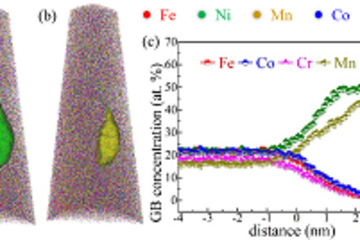All genres
21.
Talk
Influence of long-range C–C elastic interactions on the structural stability of dilute Fe–C solid solutions. EUROMAT 2009, Glasgow, UK (2009)
22.
Talk
Influence of long-range C-C elastic interactions on the structural stability of dilute Fe-C solid solutions. Invited Talk at ICAMS, Bochum, Germany (2009)
23.
Talk
Multi-scale modeling of the phase stability of interstitial Fe-C solid solutions. Invited talk at MPI for Metal Research, Stuttgart, Germany (2009)
24.
Talk
An atomistic study of low-C tetragonal Fe-C states. DPG Spring Meeting 2009, Dresden, Germany (2009)
25.
Talk
Reciprocal-Space Approach of Highly Inhomogeneous Systems. APS Spring Meeting 09, Pittsburgh, PA, USA (2009)
26.
Talk
Modeling of the strain-induced interaction between carbon atoms in Fe-C solid solution using embedded atom method potential. Contemporary Problems of Metal Physics, Kiev, Ukraine (2008)
27.
Talk
Atomistic modeling of the strain-induced interaction between carbon atoms in Fe-C solid solution. Computational Materials Science Workshop, Ebernburg Castle, Germany (2008)
28.
Talk
Atomistic modeling of the strain-induced interaction between carbon atoms in Fe-C solid solution. XVII International Materials Research Congress 2008, Cancun, Mexico (2008)
29.
Talk
An ab-initio study of the phase transitions in the interstitial Fe–C solid solutions. Spring meeting of the German Physical Society (DPG), Berlin, Germany (2008)
30.
Poster
Martensite formation in dilute Fe-based solid solutions: Ab initio based multi-scale approach. Ab initio Description of Iron and Steel: Mechanical properties, 468. Wilhelm und Else Heraeus-Seminar, Ringberg, Germany (2010)
31.
Poster
Martensite formation in dilute Fe-based solid solutions: Ab initio based multi-scale approach. Ab initio Description of Iron and Steel: Mechanical properties, 468. Wilhelm und Else Heraeus-Seminar, Ringberg, Germany (2010)
32.
Poster
Order/disorder transition of defects in ferrite: Ab initio based multi-scale approach. Psi-k 2010 Conference, Ab initio calculations of processes in materials and (bio)molecules, Berlin, Germany (2010)
33.
Poster
Reciprocal-space approach of highly inhomogeneous systems. Gordon Research Conference "X-Ray Science", Colby College, Waterville, ME, USA (2009)
34.
Poster
Atomistic modeling of the strain-induced interactions between C atoms in Fe–C solid solutions. International Workshop on Multiscale Materials Modelling (IWoM3), Berlin, Germany (2009)
35.
Poster
First Principles Study of Fe–C interstitial solid solutions. International Workshop on Ab initio Description of Iron and Steel (ADIS2008), Ringberg Castle, Germany (2008)











